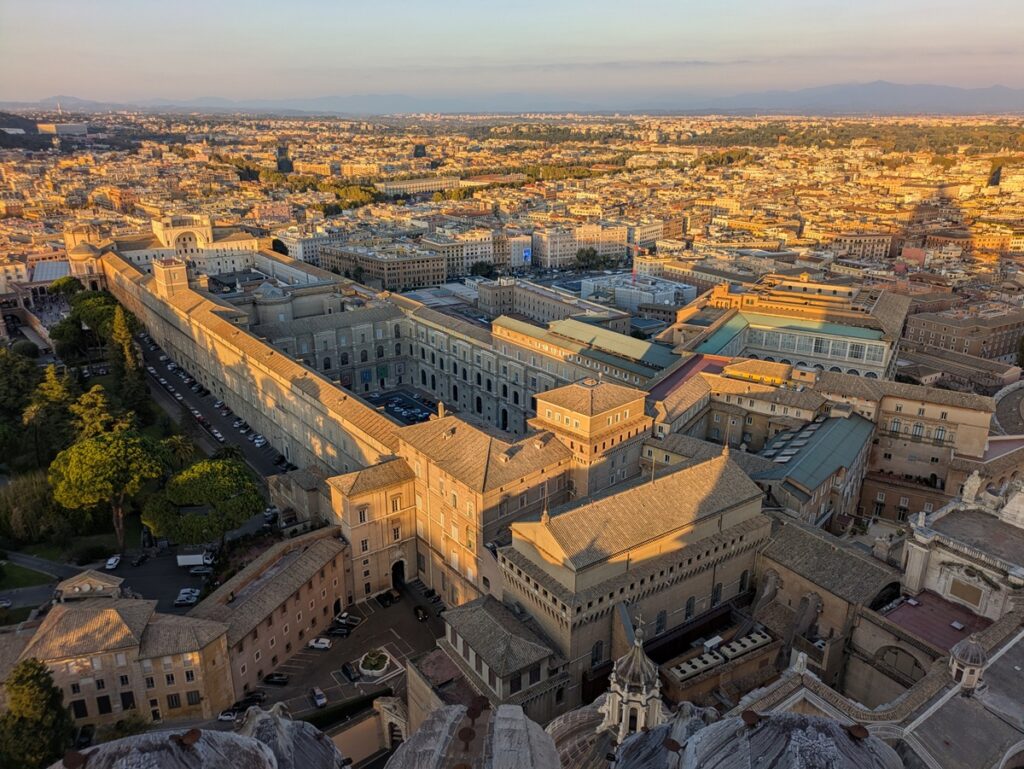
This week I have had the privilege of working in three archives in Vatican City and Rome: the Archivio Apostolico Vaticano, the Archivio Storico della Segreteria di Stato, and the Archivio di Stato di Roma. This has been a trip long in the planning, primarily due to the somewhat involved admissions processes for the two archives in the Vatican, but has been very worthwhile. I have learned a great deal about Macintosh’s time in Italy in 1790 and 1791, I have a better understanding of his relationship with Francesco Saverio de Zelada, the Cardinal Secretary of State, and I have confirmed that Macintosh did, indeed, meet with Pope Pius VI.
In addition to what I’ve learned about Macintosh, I have also gained some insight into the practicalities involved in using these three archives that are not necessarily obvious or well advertised. I thought it might be helpful, therefore, to note some of these down. These are reflections and observations based only on my very limited experience and from working with quite a narrow range of material, but I hope they will be helpful to those interested in working in the same archives.
Archivio Apostolico Vaticano
This is the largest and most famous of the archival collections contained in the Vatican and holds something in the region of 85 linear kilometres of material, much of which is stored in the “bunker” built beneath the Cortile della Pigna. As a first-time user, it can be difficult to comprehend the scope of the collection and how to identify relevant material. The archive does have a good overview document, Indice dei Fondi e relativi mezzi di descrizione e di ricerca, which showcases the overall structure of the archive and indicates which indexes describe the content of individual sections. This document is also important for subsequently ordering material, since it lists the abbreviated titles of collections that are used in the online ordering system.
For Anglophone researchers, an indispensable guide is the 1998 book Vatican archives: an inventory and guide to documents of the Holy See, edited by Francis X. Blouin, Jr. The value of this work is that it explains what is actually contained in each section of the collection and provides additional references to scholarly work on those collections. By triangulating these various sources and guides, it is possible to get a sense of whether or not a particular section contains relevant information. In addition to these two titles, which can be consulted prior to arrival in the archive, the archive itself contains a room, the Sala Indici (Leone XIII), that holds the various indexes, both printed and manuscript. This room also contains the computers through which you submit orders. One thing that I discovered is that some (perhaps all) of the indexes have been digitised and can be viewed on the computers in the Sala Indici. Via these computers it is also possible to access the intranet page of the archive, which contains additional useful information. Sadly, I don’t think any of the indexes are available for remote consultation.
It is possible to order three items per day, which are delivered to the adjoining Sala Consultazione Documenti (Pio XI). I found the delivery times quite rapid, but it is necessary to check to see whether the documents have been delivered; they are not brought to you.
Practicalities
In order to use the archives, it is necessary to apply in advance, a procedure which is explained online here. When planning a visit to the archive, it is important to check the opening times and dates, noting that the archive closes for most of the summer. Assuming your application for access is approved, you will be issued with an email that will allow you to pass the security checks to enter Vatican City by way of the Porta Sant’Anna. From there, you walk west along Via Sant’Anna, and through the archway into the Cortile del Belvedere.

The archive is not signposted (at least as far as I could see), but is accessed from the door in the northwest corner of the courtyard (this is on the same side as the Biblioteca Apostolica Vaticana).

On your first visit to the archive, it is necessary to collect an admissions card (tessera di ammissione), which can be obtained from the admissions office (Segreteria Accettazioni) on the ground floor. Once you have your card, you present it at the reception desk to receive a locker key so that you can leave your possessions in the locker room (guardaroba). The index and consultation rooms are located on the third floor of the building (accessible via a dinky lift or via the stairs). There is no assigned seating, so you can sit wherever you prefer.
The main consultation room overlooks Cortile della Biblioteca, where there is an inexpensive café (il Bar B.A.V.), where you can get drinks, snacks, and sandwiches throughout the day. It is used by staff and visitors, but is not accessible to tourists, so does not get too crowded (at least in my experience). The Cortile is a nice place to pass time while waiting for documents to arrive.
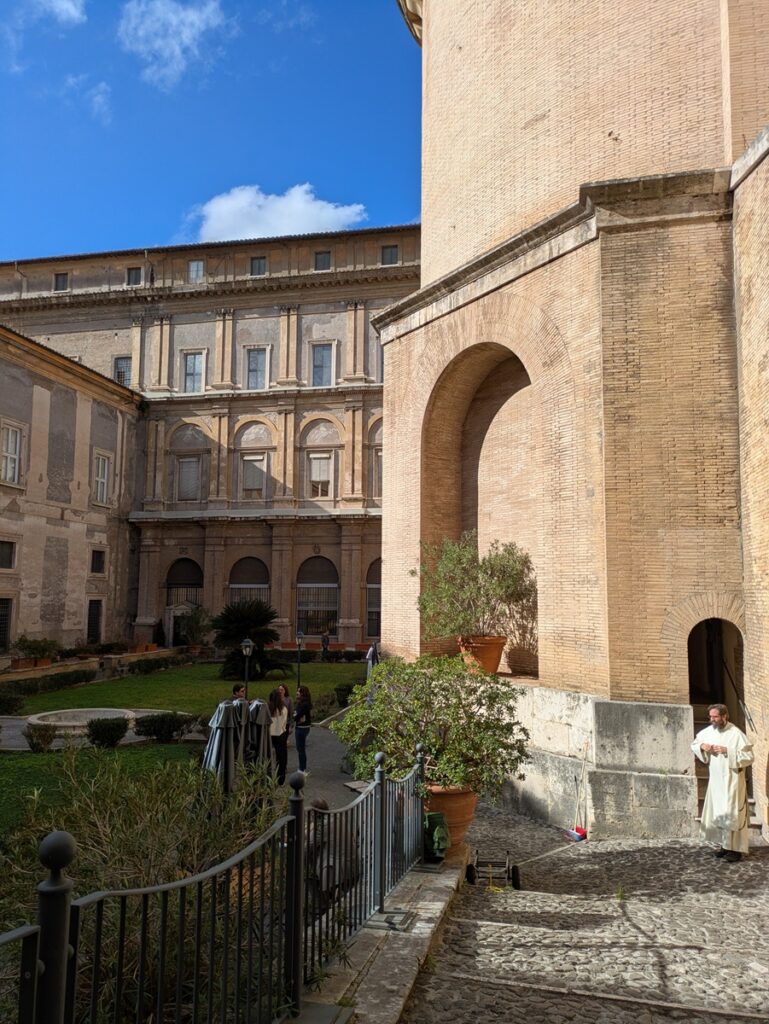
Some things to note
It is not possible to take photographs in the archive, although you can order reproductions of material (albeit at quite a steep price). The limit on the number of items that can be ordered per day means that it is important to prioritise and be selective. The archive is open for the whole day only on Mondays and Tuesdays (it is a half day for the rest of the week). In addition to the index and consultation rooms, there are two additional rooms on the level below that contain printed reference works and are where digitised materials can be viewed. In addition to the café in the Cortile, there are vending machines selling drinks and snacks near the toilets. There is no wi-fi.
Archivio Storico della Segreteria di Stato
This archive is located almost directly opposite the Archivio Apostolico, at the southern end of the Cortile del Belvedere. Like the apostolic archive, it does have a strict policy governing admission and is a little more involved with respect to the documentation you need to provide. The process is explained on the archive’s website. The archive operates an online booking system, meaning it is necessary to reserve a seat (or workstation) in the reading room. These are done in timed blocks: 9 till 11 and 11 till 1. There is a notional limit of 100 bookings per year, at which point additional permissions are required. If you miss a certain number of bookings in a year, your access can be rescinded.
Assuming your request for access has been granted, it is necessary to collect your admissions card from a rather more imposing location: the Ufficio Permessi del Corpo della Gendarmeria. To access the permissions office, it is necessary to present yourself at the Portone di Bronzo (bronze door) in the Apostolic Palace. As a first-time visitor, it is not necessarily obvious how to get there, since it is not signposted. The easiest thing to do is to enter the colonnade of St Peter’s Square, by way of Via di Porta Angelica, and pass through the security checkpoint for visitors going on to see the basilica. You then follow the colonnade to the west, and you will eventually find the Portone di Bronzo. Once you pick up your card, you retrace your steps and head back to the Porta Sant’Anna to enter Vatican City, following the same route as for the apostolic archives.

The archive is, continuing a theme, not obviously signposted and is accessed via this door. There is an key card reader and, on presenting your admissions card, the door will open, leading you into the locker room, where you can leave your possessions.
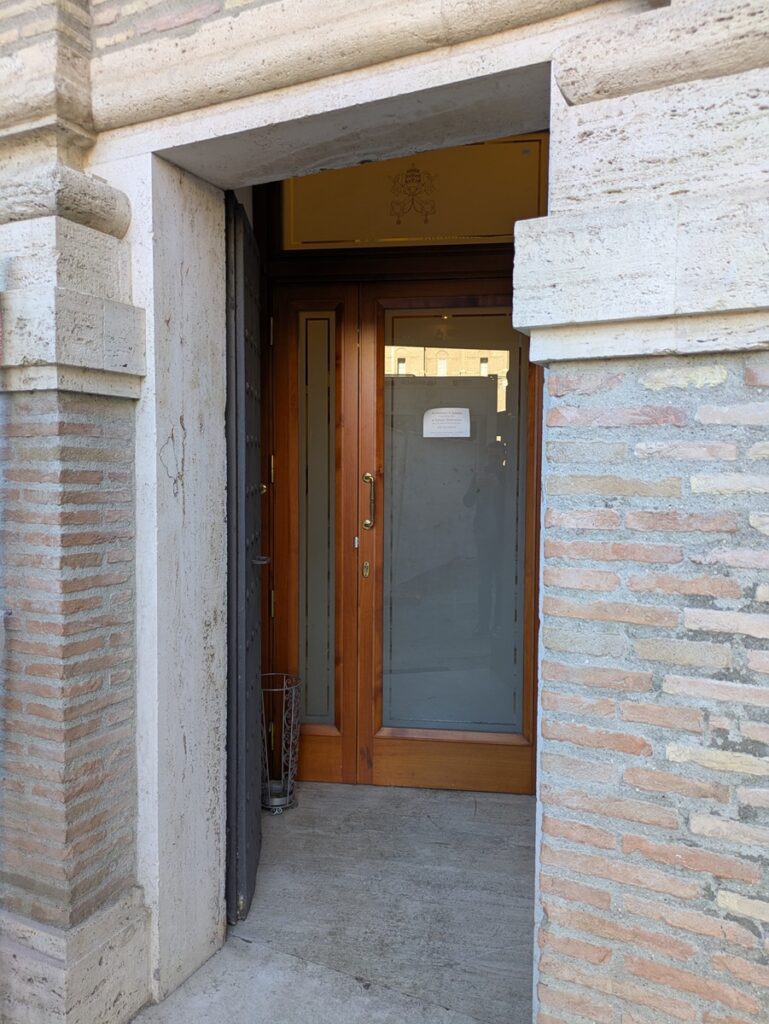
The archival reading room is a bit like a wooden spaceship and is nicely set out. You take a seat at your pre-booked workstation, where it is possible to interrogate the archival indexes and to view certain materials that have been digitised. Unlike the apostolic archive, the externally available description of the archival collection is very minimal (described on the website here), but using the workstations it is possible to get a much better sense of what is in the collection. I am not sure how much of the material is available digitally, but the items I needed to consult were available in hardcopy only and it took only about 25 minutes for the material to be delivered.
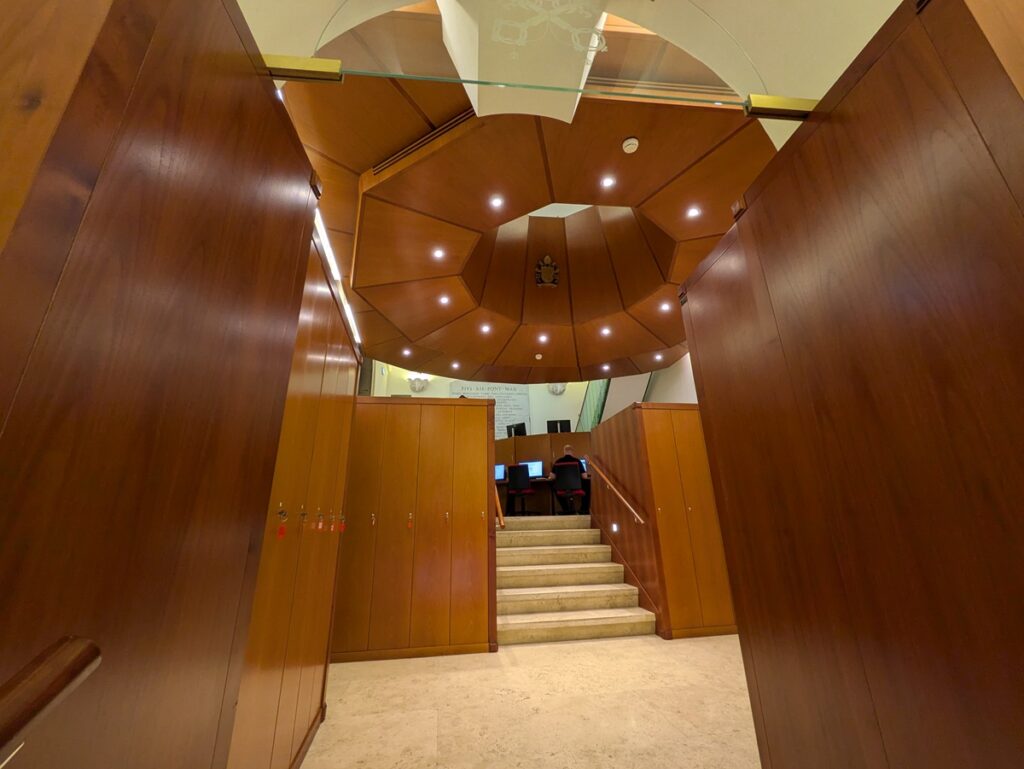
Some things to note
Like the apostolic archive, it is not possible to take photographs (although reproductions can be ordered). It is possible to order up to five items per day, but it is important to note that the opening hours are limited to 9 till 1 every day. The archive is also closed during most of the summer and also follows the standard pattern of closing on certain feast days. There is no wi-fi.
Archivio di Stato di Roma
The state archives are located in the Biblioteca Alessandrina, part of the Palazzo della Sapienza, adjoining the church of Sant’Ivo alla Sapienza. It is a beautiful building, but it also lacks signage (which is a recurring theme with archives in Rome!).
The archives have a comprehensive catalogue which can be consulted online, which eliminates some of the guesswork involved in determining whether or not it holds material relevant to one’s research interests. Material can also be ordered online in advance, even without a reader’s card. You need to register with the online system (which I believe is now common to all state archives in Italy) and place your order. Items will be held for seven days from the date of delivery.

The archive itself is located on the first floor of the palace, on the northern side. Again, there is no obvious signage, but is accessed through a glass sliding door (indicated as door XXII).
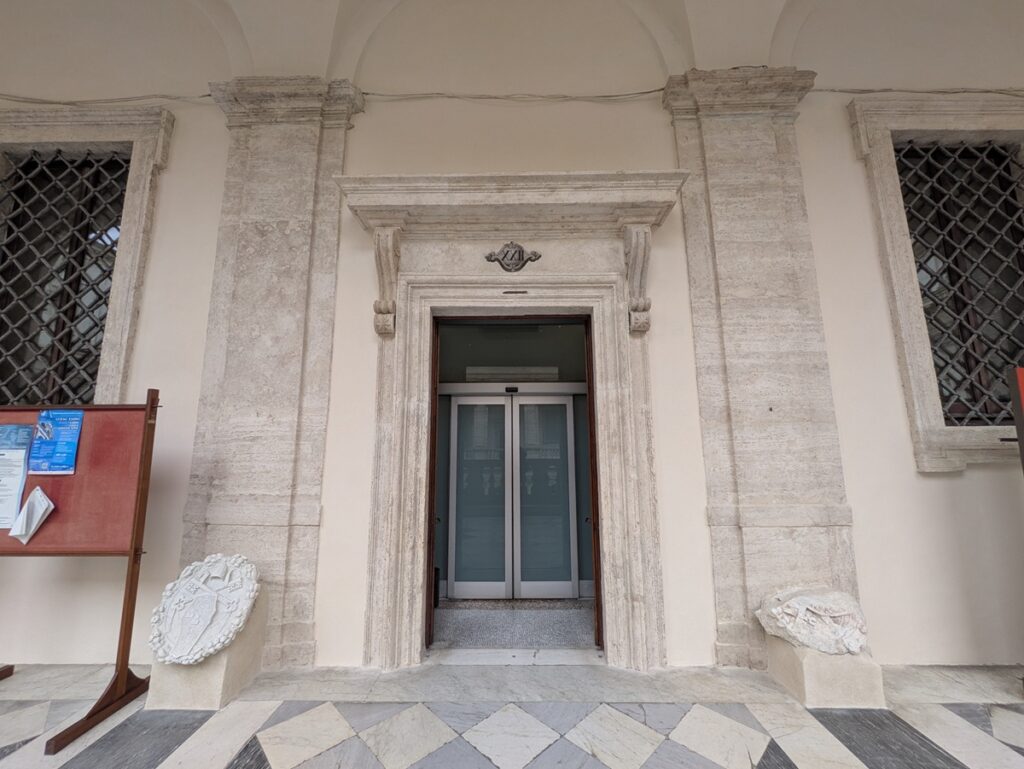
At the reception desk on the left-hand side, you can collect your admission card by presenting your identity card or passport (which will be held until you check out at the end of your visit). You will be issued with a locker key that also corresponds to your desk in the reading room. The reception desk can also provide you with the unique password needed to access the wi-fi. Items ordered in advance should be ready for immediate collection, which you can do from the issue desk next to reception.
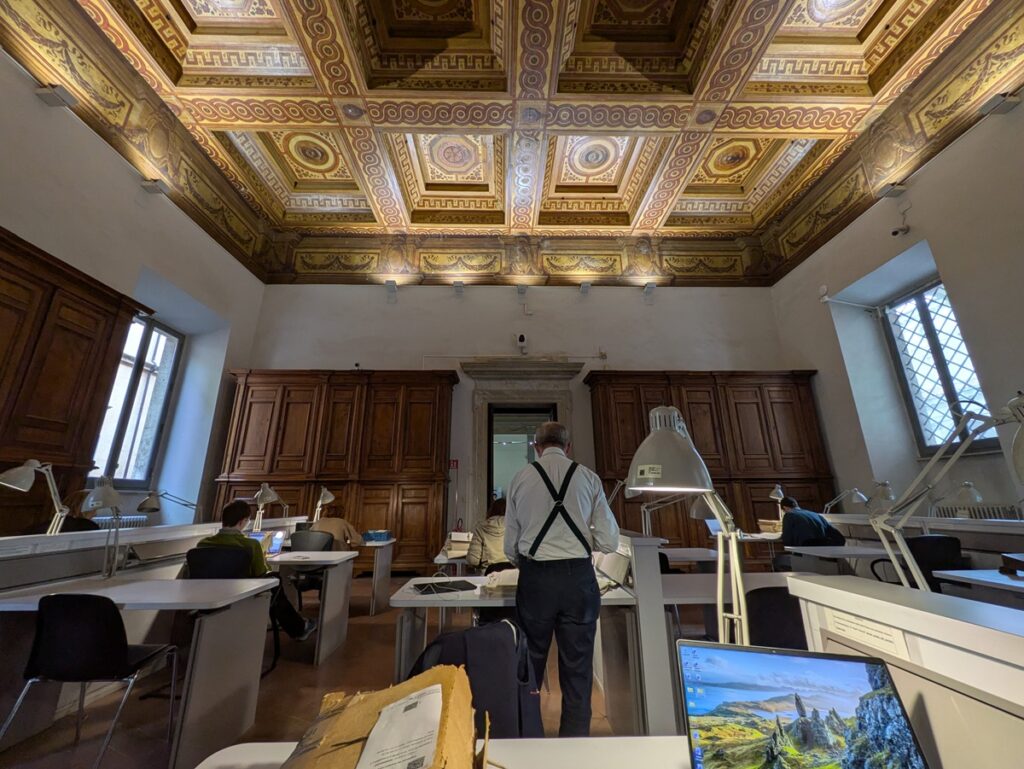
The reading room itself is extremely atmospheric, particularly the impressive coffered ceiling. Perhaps the most welcome aspect, however, is the fact that photography is permitted!
Some things to note
The archive is open Monday to Friday, 9 till 6, but researchers are limited to consulting three items per day (with some exceptions based on the type of material).
